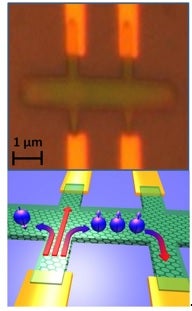Graphene spintronics
Barbaros ÖZYILMAZ (Group Leader, Graphene Research Centre) () September 03, 20143 Sep 2014. NUS physicists discovered that the spin Hall effect (SHE) in CVD graphene makes it an ideal material for future spintronics usage.
Spintronics is an emerging technology making use of the intrinsic spin of the electron, its magnetic moment and its electronic charge in semiconductor applications. The potential of graphene for spin based electronics is well known. However, a crucial ingredient, SHE, which is needed to transform charge currents into spin currents and manipulate the latter, has been missing. Over the years, many complex and costly material engineering routes have been proposed to overcome this bottleneck. The research led by Prof Barbaros ÖZYILMAZ at the Graphene Research Center in NUS has discovered that the SHE is intrinsic to graphene synthesized on metallic surfaces by means of chemical vapour deposition (CVD). The effect is extremely large (spin Hall angle ~ 0.4) and can be observed at room temperature (see Figure). Since CVD graphene is expected to be readily available on an industrial scale, this opens the path towards a rapid exploration of graphene based spintronics applications.
Manipulating electron charge is central to conventional electronic circuitry. Similarly, creating, moving and measuring electron spin is essential to spintronics. In contrast to charge based applications, spin based applications are expected to be not only more energy efficient but also enable a more unified computer architecture. This would enable more powerful computers with both, much faster transistors and much denser data storage. With the discovery of the SHE in CVD graphene, it is now possible to start engineering the building blocks of large scale spintronics circuits with a material which is at the same time ideal for flexible consumer electronics applications.

Top image shows optical picture of a typical SHE device, channel length 2 micrometers. Bottom image illustrates the creation of spin polarized currents due the SHE effect. (Picture credit: Özyilmaz B)
Reference
Balakrishnan J, Koon GKW, Avsar A, Ho Y, Lee JH, Jaiswal M, Baeck SJ, Ahn JH, Ferreira A, Cazalilla MA, Castro Neto AH, Özyilmaz B. “Giant spin Hall effect in graphene grown by chemical vapour deposition.” Nature Communications 5 (2014) 4748. doi:10.1038/ncomms5748


